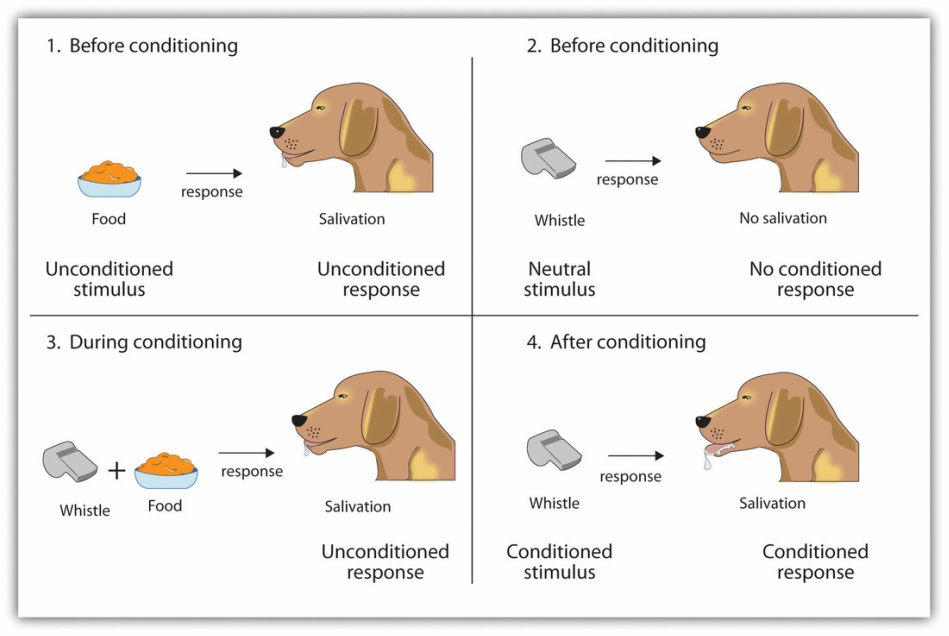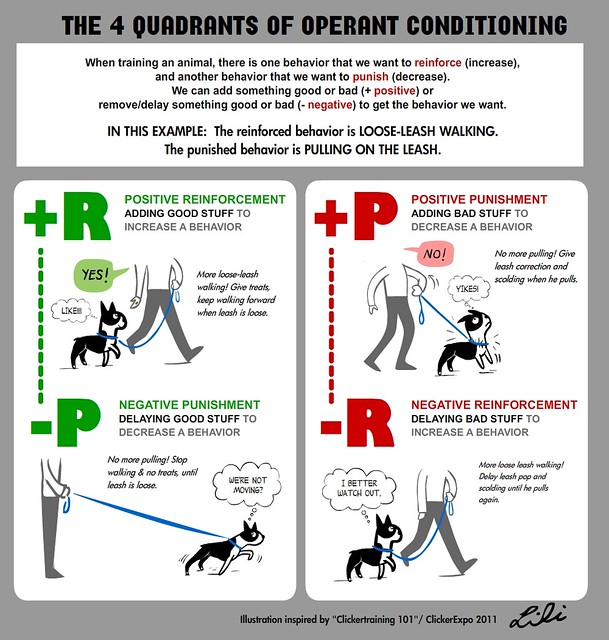Learning is the process by which life experience causes change in the behavior or thinking of an organism. Listening is not specific to only humans. Both humans and animals relate to and experience the act of listening. There are 3 distinct ways of learning. They are known as classical conditioning, operant conditioning, and observational learning.
🌀CLASSICAL CONDITIONING 🌀
Classical conditioning was mistakenly discovered by Ivan Pavlov while conducting a different experiment. "Classical conditioning is a form of learning in which animals or people make a connection between two stimuli that have occurred together such that one predicts the other (Ch 6)." In other words it is a type of learning that occurs when an association is made between a meaningful stimulus and a non-meaningful stimulus.


This learning experiment was originally tested on dogs to better understand their learning behaviors. The experiment began by placing food, an unconditioned stimulus, to acquire the goal of salivation, an unconditioned response. A whistle, a neutral stimulus, was then placed in front of the dog which purposefully caused no salivation, a no conditioned response. To then re-aquire salivation, the unconditioned response, food was brought back in the picture, but this time along with the whistle. Although the dog was only salivating because of the food, due to the whistle being paired with the food the dog subconsciously referred to both the whistle and food as the reason for salivating. In return, because the dog now views both of these objects in regards to salivating, if the whistle is shown by itself the dog still salivates because he assumes the whistle and food are now a package deal. "Once the dogs learned that the whistle predicted food, they salivated to the whistle just as automatically and involuntarily as they always had to food itself (Ch 6)."
😃OPERANT CONDITIONING😔
"B. F. Skinner believed all behavior is determined by its consequences, so we have no free will to act as we want (Ch 6)." This belief led him to discover operant conditioning. Operant Conditioning is the learning of voluntary behavior through the effects of pleasant and unpleasant consequences.

Example:

Positive reinforcement involves obtaining something desired. Negative reinforcement involves removing a desired object or wish. Skinner found most success in his experiment when he discovered reinforcement schedules. "Reinforcement schedules are patterns by which reinforcements occur in response to a particular behavior. The two types of reinforcement schedules are known as ratio schedules and interval schedules. A fixed-ratio schedule is a reinforcement schedule in which a behavior is reinforced after a consistent, predictable number of occurrences. In contrast, a variable-ratio schedule is a reinforcement schedule in which a behavior is reinforced after an inconsistent, unpredictable number of occurrences. A fixed-interval schedule is a reinforcement schedule in which a behavior can be reinforced after a time interval that is consistent and predictable. By contrast, a variable-interval schedule is a reinforcement schedule in which a behavior can be reinforced after a time interval that is inconsistent and unpredictable (Ch 6)." By using the different types of reinforcements and reinforcement schedules, Skinner accurately provided examples by which reinforcement ensures valid behavior.
👀OBSERVATIONAL LEARNING🙈🙉🙊
Observational learning was discovered by Albert Bandura and his colleagues. It was discovered via the experiments known as the Bobo Doll Studies. Observational learning is learning that occurs as a result of observing others’ behavior and consequences rather than your own.


👀OBSERVATIONAL LEARNING🙈🙉🙊
Observational learning was discovered by Albert Bandura and his colleagues. It was discovered via the experiments known as the Bobo Doll Studies. Observational learning is learning that occurs as a result of observing others’ behavior and consequences rather than your own.


The experiments Bandura and his colleagues used involved an adult, a preschool-aged child, and a Bobo doll, a large standup inflatable punching bag figure with a clown painted on it. Children observed as they watched adults interact with these dolls. The children either saw the adult ignore the Bobo doll or act aggressively toward it. "The aggressive adult kicked the doll, yelled at it, punched it, and hit it with a hammer. How the children dealt with their frustration depended on what they had observed in the adult. The children who saw the adult act aggressively toward the Bobo doll were more likely to act aggressively themselves than the children who saw the adult ignore the Bobo doll. They kicked it, yelled at it, punched it, and hit it with a hammer—just as they had seen the model do moments earlier (Ch 6).
Personal Learning
I personally enjoyed reading about these distinct different ways to learn. I can relate to each one and presently I still see these as ways in which I learn. I feel observational learning and operant conditioning have had the most effects on my learning behaviors. The one I enjoyed reading about the most was operant conditioning. I enjoyed reading about this mainly because I found a related picture that pertained to dog walking- something that I have struggled with. Operant conditioning provided me with more efficient ways to best walk my dogs and train future dogs of mine as well.
Real World Application
As previously stated, I have found each of these learning styles present in my life. I remember as a child through pre-teen years I learned a lot through observational learning. Media, music, friends, and role-models had significant impacts on how I acted. As I grew older operant conditioning ruled my actions. If I wasn't making good grades or listening to my authoritative instruction I would have my phone or television taken away. I remember my mom used classical conditioning the most. For example, she would honk her horn when it was time to leave the house or unpack groceries from the car. In addition, she would show me my dad's belt if I was misbehaving. The belt signified spankings, which promoted fear, which in return put me in my best behavior real quick. I believe these ways of learning are experienced by everyone. Observational learning promotes ethics. Operant conditioning promotes acceptable behavior for different situations. Classical conditioning promotes obedient and responsive behavior. Although everyone has experienced each of these, there is not one which responds best with everyone. No human is alike and therefore, each person will react to these types of learning differently and agree or disagree with each one differently.
Personal Learning
I personally enjoyed reading about these distinct different ways to learn. I can relate to each one and presently I still see these as ways in which I learn. I feel observational learning and operant conditioning have had the most effects on my learning behaviors. The one I enjoyed reading about the most was operant conditioning. I enjoyed reading about this mainly because I found a related picture that pertained to dog walking- something that I have struggled with. Operant conditioning provided me with more efficient ways to best walk my dogs and train future dogs of mine as well.
Real World Application
As previously stated, I have found each of these learning styles present in my life. I remember as a child through pre-teen years I learned a lot through observational learning. Media, music, friends, and role-models had significant impacts on how I acted. As I grew older operant conditioning ruled my actions. If I wasn't making good grades or listening to my authoritative instruction I would have my phone or television taken away. I remember my mom used classical conditioning the most. For example, she would honk her horn when it was time to leave the house or unpack groceries from the car. In addition, she would show me my dad's belt if I was misbehaving. The belt signified spankings, which promoted fear, which in return put me in my best behavior real quick. I believe these ways of learning are experienced by everyone. Observational learning promotes ethics. Operant conditioning promotes acceptable behavior for different situations. Classical conditioning promotes obedient and responsive behavior. Although everyone has experienced each of these, there is not one which responds best with everyone. No human is alike and therefore, each person will react to these types of learning differently and agree or disagree with each one differently.
Taryn, I really did enjoy reading your blog post about learning this week. It was very detailed and organized and I even picked up on a few different things that I had just glimpsed over for myself. It was so cool how you spent a good amount of time talking about how you saw the learning styles present in your own life. After reading your post, I was able to look back in my own life and better understand the learning process.
ReplyDeleteTaryn,
ReplyDeleteGood thing you found practical ways to apply this type of conditioning to your dogs. Making this knowledge part of your practical life will help you grow more quickly in this learning. Each example that you shared with us was very significant to me, in many of those actions I remembered my parents too.
It is interesting how the simplest forms of learning help us. I always think that the dog experiment is funny because it reminds me of how coaches treat their players. I have gotten to the point (after 7 years of playing football) that if I hear a whistle I start to run my feet to get ready for up downs! But great blog, the pictures are good, keep it up!
ReplyDelete